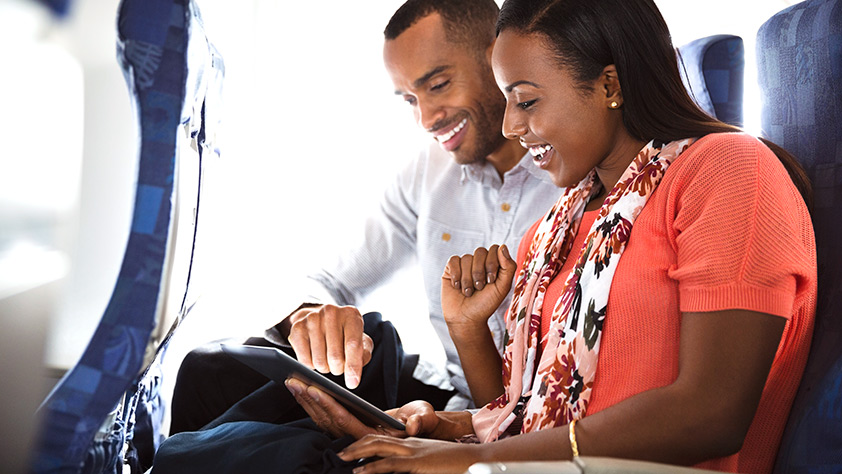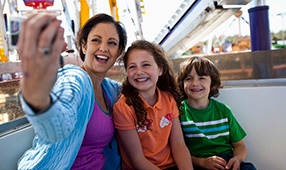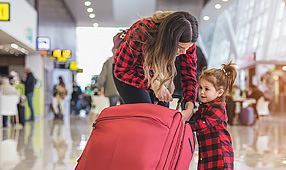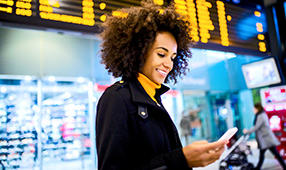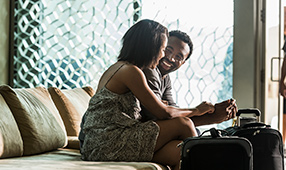Gone are the days of enjoyable, yet affordable, air travel. At least, it certainly seems that way on most flights, where we’re met with overpriced meals, uncomfortable seats and malfunctioning TV screens.
But flying doesn’t have to be unpleasant.
The most important thing is to start with the right attitude, says Rishi Piparaiya, author of Aisle Be Damned: “We’re talking about an extremely complicated industry, where millions of people fly in the skies in metal tubes at the speed of sound. Sure, something may go wrong, but our ancestors would spend a lifetime to make the journey we make in half a day.”
Even if you’re not traveling with children, you can greatly improve your travel experience by being prepared.
“Arrive early, allow for plenty of time to get through security, prepare for the unexpected, and have a Plan B ready to implement at a moment’s notice,” says Brianna Meighan, author of How to Fly With a Baby.
She suggests familiarizing yourself with the latest requirements and/or restrictions for TSA Security by visiting tsa.gov.
We asked several air travel experts to share their best travel-planning tips to help you have a smooth experience, both at the airport and on the plane:
Before you buy your ticket
Sign up for the TSA program. Eligible travelers can zip through the security line with the TSA Pre-Check program, which lets you keep your shoes, belt and coat on, and you won’t need to remove your laptop from its case.
The fee for this service is $85, and that covers you for five years. If you’re approved to participate, you’ll need to enter your “Known Traveler Number” when you make your airline reservations.
Note that not everyone is eligible for this new program, and not all airlines participate. Visit tsa.gov/tsa-precheck/ for more information.
When you buy your ticket
Consider upgrading to business class or first class. This is perhaps the best, albeit most expensive, way to improve your travel experience. Fortunately, there are inexpensive ways to attain upgrades, including elite status on frequent flier programs. However, many credit cards offer upgrades, lounge passes, priority boarding and discounted in-flight amenities just for signing up, says Scott Keyes, author of the e-book How to Fly for Free.
“Most lounges allow people to bring a guest, as well,” he says. “Hang outside the entrance, and when a solo traveler approaches, ask her if she’s willing to bring you in as her guest.”
Bid on last-minute upgrades. Many airlines allow passengers to do this, says Meighan, adding that all-access yearly passes to hundreds of airport lounges can be purchased for as low as $99 per year.
If your flight is overbooked and you’re able to be flexible, you can offer to be bumped and receive more than just a voucher, Keyes says: “Ask the gate agent if she can offer you a first-class seat on the next flight—or even a direct flight instead of one with a layover.”
Inspect your seating arrangement. After you book your flight, visit seatguru.com to find the best seat, Keyes says: “It’ll show you which seats on your specific flight have the most legroom or other amenities, like power outlets.”
A few days before your flight
Get snacks. Don’t rely on a tiny bag of peanuts on the plane to curb your hunger pangs. Stash some healthful snacks in your purse or carry-on so you and your children won’t get cranky. Pack a bag of grapes, some granola bars, trail mix—even peanut butter and jelly sandwiches.
If you need a little liquid courage to get through your flight, bring a few mini-bottles with you, Keyes says: “They cost under $2 and are less than 3 ounces, so you can bring them through security.” With alcoholic beverages costing a stiff $7 or more in-flight, you’ll save money, too.
Download movies/apps/books. Keyes recommends loading your devices with long articles and books you’ve been meaning to read so you can enjoy them even if Wi-Fi isn’t available.
Meighan says that’s a smart idea, especially because you can’t rely on the airline TV to be functioning—or playing something you want to watch.
“Entertainment is the best cure for boredom, so before I fly, I load my iPad mini full of movies, TV shows, apps and even new books,” Meighan says. “It’s best to just be prepared with my own source of entertainment.”
This is critical is you’re flying with children. Download fun apps, and also pack a few books, coloring books and crayons for when they need a break from staring at a screen.
Double-check luggage and carry-on requirements. Your airline’s website should list the maximum weight and size that it allows for bags. “Unexpected surprises are never fun, so it’s best to do your homework before your travel day arrives,” Meighan says.
24 hours before your flight
Check in online. You’ll save a lot of time when you bypass the check-in line at the airport and head straight to security, especially if you’re not checking a bag, Meighan says.
Select a comfortable outfit. That includes slip-on shoes that you can easily get in and out of amid the bustle at the security checkpoint.
Pack your carry-on for easy access. Make sure you have your kids’ favorite snacks, games and movies packed and available within arm’s reach, Meighan says, and all electronics should be fully charged before take-off.
“If kids are occupied, chances of a meltdown are far lower,” Piparaiya says. “Babies and toddlers face painful pressure in ears during takeoff and landing, so give them a milk bottle or a lollipop. The sucking motion helps prevent this pain in ears due to pressure changes.”
At the airport
Check-in at the curb. You’ll pay a small fee to have your bags processed at the curb, but you’ll save time because the line outside usually is shorter than the one inside.
Grab a meal if you’ll need it. Whether you make sandwiches at home or you grab a bite to-go at the airport, you’ll likely save money versus buying an in-flight meal. Plus, you can eat whenever you get hungry instead of having to wait for the food cart to roll down the aisle.
Keep your stress levels in check. Getting into the right mindset is especially important for parents traveling with children, Meighan says. “Children respond to their parents’ stress level, so it’s extremely important for parents remain calm so that their little one can do the same,” she says.
